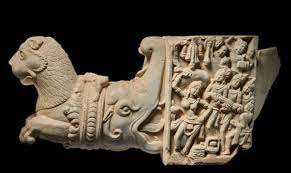NEW YORK, July 18: More than 140 objects highlighting early Buddhist art in India and dating from 200 BCE to 400 CE will be on display at the prestigious Metropolitan Museum of Art (Met) here, with the exhibition presenting a series of “evocative and interlocking” themes to reveal pre-Buddhist origins of figurative sculpture in India.
The exhibition ‘Tree & Serpent: Early Buddhist Art in India, 200 BCE–400 CE’, made possible by Reliance Industries Limited, The Robert H. N. Ho Family Foundation Global, and the Fred Eychaner Fund, will run from July 21 to November 13, 2023, at the Met.
A special preview and reception to celebrate the opening of the exhibition was held at the prestigious museum Monday and was attended by India’s Ambassador to the US Taranjit Singh Sandhu, US Ambassador to India Eric Garcetti, founder and chairperson of Reliance Foundation Nita M Ambani, Consul General of India in New York Randhir Jaiswal and other prominent members of the diaspora and American community.
Featuring more than 140 objects dating from 200 BCE to 400 CE, the exhibition “presents a series of evocative and interlocking themes to reveal both the pre-Buddhist origins of figurative sculpture in India and the early narrative traditions that were central to this formative moment in early Indian art.”
Garcetti, who flew from New Delhi, especially for the opening of the exhibition, told PTI that occasions such as these highlight the strong India-US ties and said the friendship between the two countries “has never been stronger.”
“Americans in the world are learning more and more about India, about its history, about the religious past, about the ways that we can connect the world better together.”
“This bridge that we’re building has never been stronger. Cross that bridge and see India here in New York, and vice versa,” he said.
The Met said that the exhibition is “the story of the origins of Buddhist art. The religious landscape of ancient India was transformed by the teachings of the Buddha, which in turn inspired art devoted to expressing his message. Sublime imagery adorned the most ancient monumental religious structures in ancient India, known as stupas.
“The stupa not only housed the relics of the Buddha but also honoured him through symbolic representations and visual storytelling. Original relics and reliquaries are at the heart of this exhibition, which culminates with the Buddha image itself,” it said in a statement.
With major loans from a dozen lenders across India, as well as from the United Kingdom, Europe, and the United States, the exhibition “transports visitors into the world of early Buddhist imagery that gave expression to this new religion as it grew from a core set of ethical teachings into one of the world’s great religions.”
In the exhibition, objects associated with the Indo-Roman exchange reveal India’s place in early global trade.
“The exhibition showcases objects in various media, including limestone sculptures, gold, silver, bronze, rock crystal, and ivory,” the Met said adding that highlights include “spectacular sculptures” from southern India—newly discovered and never before publicly exhibited masterpieces—that add to the world canon of early Buddhist art.
Earlier in the day, a repatriation ceremony was held in the Consulate General of India in New York where a total of 105 trafficked antiquities stolen from India were handed over by the US.
Garcetti said this is a “priority” for US President Joe Biden and him and the Met has been “critical” in identifying artifacts stolen from across the world and helping in efforts to repatriate them to their rightful homes.
He said India and the US are “negotiating a permanent agreement” to have a “framework for cultural exchange, repatriation and making sure that these flows go both ways.”
“This is like a gift to America and to the world to have these pieces here. I want to thank the states in India that contributed, the government of India that contributed.”
On Prime Minister Narendra Modi’s State Visit to the US last month, Garcetti said “We are still flying high. This wasn’t a one-moment thing. This is a movement, not a moment. This is going to be for the rest of our lifetimes a deepening relationship in culture and security,” he said adding that for “peace, prosperity, planet, people, the US and India are better together.” (PTI)
Home International Metropolitan Museum of Art hosts exhibition highlighting early Buddhist art in India


